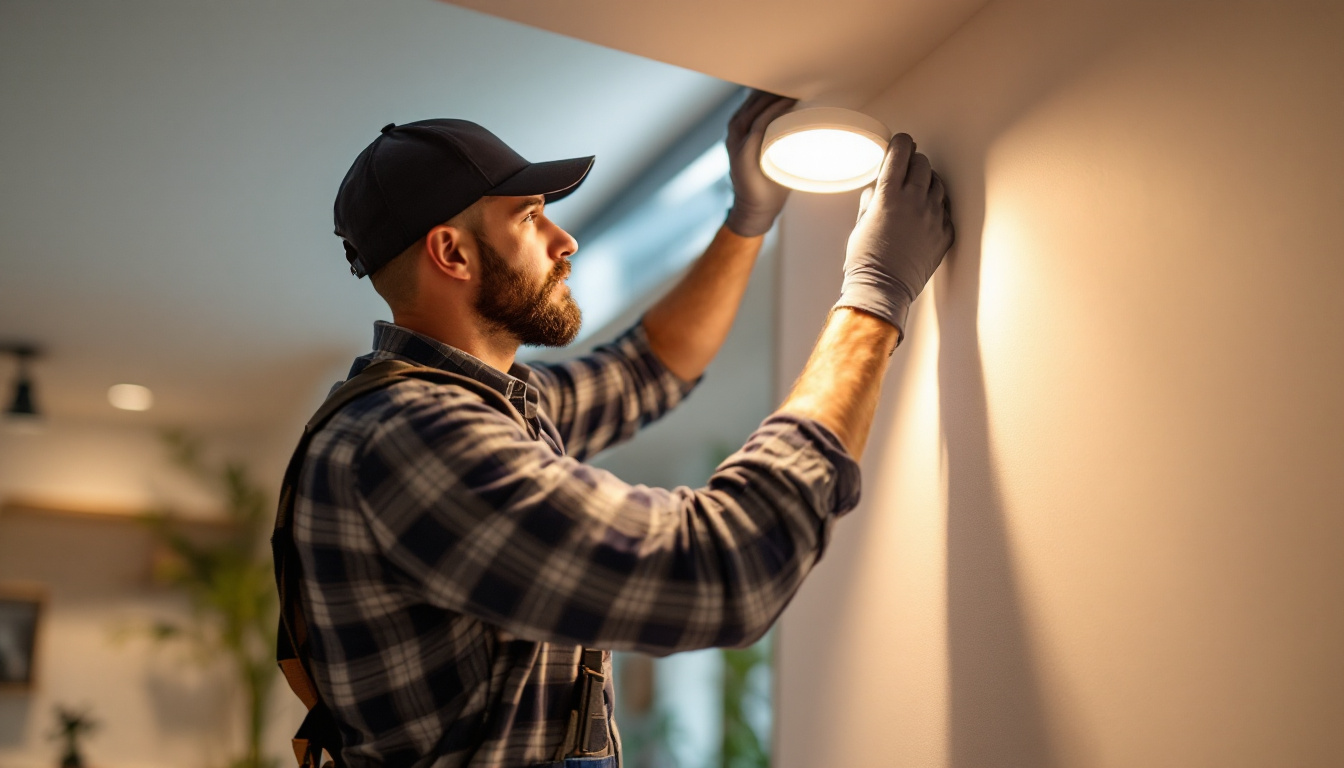
In the competitive world of lighting contracting, staying ahead of the curve is essential for winning bids and satisfying clients. One effective strategy that has gained traction in recent years is the recessed lighting retrofit. This approach not only enhances the aesthetic appeal of spaces but also improves energy efficiency and functionality. Understanding the benefits and implementation of recessed lighting retrofits can position contractors as leaders in their field, ultimately helping them secure more projects.
Recessed lighting, often referred to as can lighting or downlighting, involves installing light fixtures that are set into the ceiling, creating a clean and streamlined look. A retrofit, in this context, means upgrading existing fixtures or systems to improve performance without the need for a complete overhaul. This can involve replacing outdated bulbs with energy-efficient LED options, enhancing the fixture design, or even integrating smart technology.
There are several compelling reasons for lighting contractors to consider offering recessed lighting retrofits as part of their services. First and foremost, these upgrades can significantly enhance a space’s ambiance. By providing targeted lighting, contractors can help clients achieve the desired mood and functionality in various environments, from residential homes to commercial spaces. The versatility of recessed lighting allows it to be used in a variety of settings, whether it’s illuminating a cozy living room, highlighting artwork in a gallery, or providing task lighting in a kitchen. This adaptability makes it a popular choice among homeowners and business owners alike.
Moreover, retrofitting existing lighting systems with energy-efficient solutions can lead to substantial cost savings for clients. LED lights consume less energy, have a longer lifespan, and reduce maintenance costs. This not only appeals to environmentally conscious clients but also aligns with the growing trend of sustainability in construction and renovation projects. Additionally, the reduced heat output of LED fixtures can contribute to lower cooling costs in warmer months, further enhancing their appeal as a smart investment. Clients can enjoy the benefits of modern lighting technology while also contributing to a greener planet.
As energy costs continue to rise, more clients are seeking ways to reduce their utility bills. This has created a strong demand for energy-efficient lighting solutions. By incorporating recessed lighting retrofits into their offerings, contractors can tap into this market trend and position themselves as experts in energy-efficient solutions. The growing awareness of climate change and the importance of reducing carbon footprints has led many consumers to prioritize energy efficiency in their purchasing decisions, making it a lucrative niche for contractors to explore.
Furthermore, many local and national governments have introduced incentives for energy-efficient upgrades, such as tax credits and rebates. Contractors who are knowledgeable about these programs can provide valuable guidance to clients, making their services even more appealing. This not only helps clients save money but also fosters a sense of community responsibility as they participate in initiatives aimed at reducing energy consumption. Additionally, as smart home technology continues to evolve, integrating smart controls with recessed lighting retrofits can offer clients enhanced convenience and control over their lighting environments, making these upgrades even more attractive in today’s tech-savvy market.
While the benefits of recessed lighting retrofits are clear, contractors must also consider various factors to ensure successful implementation. Understanding the technical aspects, design principles, and client preferences is crucial for delivering high-quality results.
When planning a recessed lighting retrofit, contractors should begin by assessing the existing electrical infrastructure. This includes evaluating the type of fixtures currently in use, the condition of wiring, and the overall layout of the space. Proper assessment ensures that the retrofit will be compatible with the existing system and meet safety standards.
Additionally, selecting the right LED products is essential. Not all LEDs are created equal; contractors should consider factors such as color temperature, brightness, and beam angle to achieve the desired lighting effect. Offering a variety of options allows clients to choose solutions that best fit their aesthetic and functional needs.
Moreover, contractors should also take into account energy efficiency ratings and lifespan of the LED products they select. High-quality LEDs not only reduce energy consumption but also have a longer operational life, which can significantly lower maintenance costs over time. Understanding the latest advancements in LED technology, such as smart lighting systems that can be controlled via mobile apps, can further enhance the appeal of the retrofit to tech-savvy clients.
Beyond technical considerations, the design aspect of recessed lighting retrofits cannot be overlooked. The placement of fixtures plays a significant role in how light is distributed throughout a space. Contractors should be familiar with design principles such as layering light, using focal points, and creating balance to enhance the overall aesthetic.
For instance, in a living room, a combination of recessed lighting and accent lights can create a warm and inviting atmosphere. In contrast, in a commercial setting, strategic placement of recessed lights can highlight products or architectural features, drawing attention where it is needed most.
Furthermore, understanding the impact of light on color perception is vital. Different color temperatures can alter how colors are viewed in a space, affecting the mood and ambiance. For example, warmer tones can make a room feel cozy and intimate, while cooler tones can create a more vibrant and energetic environment. Contractors should engage in discussions with clients about their vision and how light can be manipulated to achieve that vision, ensuring that the final result aligns with their expectations and enhances the functionality of the space.
Once contractors have the technical know-how and design principles in place, the next step is to effectively market these services. A well-thought-out marketing strategy can significantly impact a contractor’s ability to win bids and attract new clients.
In today’s digital age, having a strong online presence is crucial. Contractors should invest in a professional website that showcases their portfolio, including before-and-after images of previous recessed lighting retrofits. This visual evidence can be a powerful tool in convincing potential clients of the benefits of their services.
Additionally, utilizing social media platforms to share project highlights, client testimonials, and informative content about the advantages of recessed lighting can help build a community of engaged followers. This not only enhances brand visibility but also establishes the contractor as an authority in the field. Engaging with followers through live Q&A sessions or interactive polls can further increase engagement and provide valuable insights into customer preferences and concerns.
While digital marketing is essential, personal relationships still play a significant role in the contracting industry. Networking with architects, interior designers, and real estate professionals can lead to referrals and collaborative opportunities. Attending industry events, trade shows, and local business gatherings can help contractors forge valuable connections that may result in more bids.
Moreover, maintaining relationships with past clients can lead to repeat business. Offering follow-up services, such as maintenance checks or upgrades, can keep contractors top of mind for future projects. Sending personalized thank-you notes or holiday greetings can also reinforce these relationships, making clients feel valued and appreciated. Additionally, hosting workshops or informational sessions about the latest trends in recessed lighting can position contractors as thought leaders in the industry, attracting new clients through educational initiatives.
To further illustrate the effectiveness of recessed lighting retrofits, it can be beneficial for contractors to share case studies or success stories. These examples can provide potential clients with tangible evidence of the benefits and possibilities that come with such upgrades.
Consider a case where a contractor undertook a retrofit project in a suburban home. The existing lighting was outdated and inefficient, leading to high energy bills and a lackluster ambiance. By replacing the old fixtures with modern recessed lighting and incorporating LED technology, the contractor not only improved the home’s energy efficiency but also transformed its aesthetic appeal.
The homeowner reported a significant reduction in energy costs and received numerous compliments from guests on the new lighting design. This success story can be shared in marketing materials to demonstrate the potential benefits of recessed lighting retrofits to prospective clients.
In a commercial setting, a contractor may have worked on a retail space that struggled with visibility and customer engagement due to poor lighting. By retrofitting the existing fixtures with recessed lighting, the contractor was able to create a more inviting atmosphere that highlighted products effectively.
As a result, the business saw an increase in foot traffic and sales, showcasing how strategic lighting can directly impact a company’s bottom line. Sharing such examples can resonate with business owners looking to enhance their spaces and drive profitability.
As the demand for energy-efficient and aesthetically pleasing lighting solutions continues to grow, recessed lighting retrofits present a significant opportunity for lighting contractors. By understanding the benefits, mastering the technical and design aspects, and effectively marketing these services, contractors can position themselves as leaders in the industry.
With the right approach, recessed lighting retrofits can not only enhance the quality of light in various spaces but also help contractors win more bids and build lasting relationships with clients. Embracing this trend could very well be the key to thriving in an increasingly competitive market.
Ready to elevate your lighting projects and outshine the competition? LumenWholesale is your trusted partner, offering an extensive selection of spec-grade lighting products at unbeatable wholesale prices. Say goodbye to middleman markups and hello to superior quality without the inflated costs. With our commitment to reliability and performance, plus the convenience of free shipping on bulk orders, you can confidently bid on recessed lighting retrofits and more. Don’t compromise on quality or value—choose LumenWholesale for Wholesale Lighting at the Best Value and light up your clients’ spaces with excellence.

Discover why the LED Bulb T Type is revolutionizing the lighting industry and becoming a must-have for contractors.

Explore the pros and cons of Keystone Light Bulbs compared to other lighting options in this insightful guide for contractors.

Discover the essential strategies lighting contractors need to master industrial light fixtures.

Discover essential tips and strategies for lighting contractors in “Light Cabin: Avoiding Pitfalls.” This guide offers expert advice on navigating common challenges, ensuring successful projects, and enhancing client satisfaction in the lighting industry..